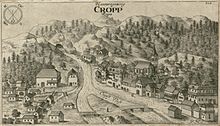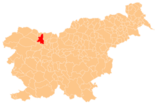Kropa
|
Kropa Kropp |
|||
|
|||
| Basic data | |||
|---|---|---|---|
| Country |
|
||
| Historic region | Upper Carniola / Gorenjska | ||
| Statistical region | Gorenjska (Upper Carniola) | ||
| local community | Radovljica | ||
| Coordinates | 46 ° 18 ' N , 14 ° 12' E | ||
| Residents | 839 (2008) | ||
| Post Code | 4245 | ||
| License Plate | Radovljica | ||
| Structure and administration | |||
| Website | |||

Kropa ( German : Kropp , older also Siedendorf ) is a village in the municipality of Radovljica in the Gorenjska region in Slovenia .
Location and inhabitants
Kropa is located in the south of the Radovljica municipality and has 839 inhabitants.
“Plac” - main square
Regardless of which of the three winding roads you take to get to Kropa, you will always reach the town's main square, called “Plac”. The road leads upwards along the stream in the direction of the narrowest part “Kotel” and further up to “Jamnik”, down the stream one arrives at the lower part (Spodnji konec).
The old settlement got its appearance at the end of the 18th century with a number of foundry houses, two churches and buildings for technical iron processing.
Cultural and historical monument
As one of the most important industrial centers, Kropa preserved the characteristics of a Krainer iron processing settlement. As far as urban characteristics, but also technical, cultural and historical monuments are concerned, Kropa is one of the most important historical places in Slovenia. It has been under legal protection as a cultural monument since 1953.
history
The boom in Kropa began in the 14th century, when forest iron smelting began to shift from the ore deposits on the Jelovica into the valley and down to the streams. The remains of the Slovenian smelting furnaces on the road up to Jamnik also date from this period. In the 15th century two blast furnaces (upper and lower iron foundry) and forges were built. Within the framework of the iron foundries, there was a production scheme from ore to bolt nails for sales at home and abroad. Foundry owners lived and worked together with iron smiths - nail manufacturers. From 1550 Kropa enjoyed a special autonomy granted by Ferdinand's Mining Regulations, regardless of the landowners. It was under the direction of a mining judge. The law remained in force until the reforms of Emperor Joseph II in 1781. Until the end of the Habsburg Empire, the village belonged to the Kronland Carniola , with Kropa forming an independent municipality in the judicial district of Radmannsdorf (political district of Radmannsdorf ).
Waters
The Kroparica (older name also Preprovka) is a rapidly flowing, steep mountain stream. In the first half of the 19th century, he turned 50 water wheels for the bellows and hammer mills of foundries and forges over a length of 1,200 meters.
Ore deposit
The area around Kropa was rich in brown iron ore. In the distant past it was washed out by the water and deposited in loam veins up to 50 meters deep, in other places just below the surface.
Historic blast furnace in Dno
In the course of the road construction from Kropa to Jamnik in 1953, the remains of a historical blast furnace from the 14th century were found. The discovery of this furnace, which was most likely built between the second half of the 13th and the early 14th centuries, represents a rare and important find of the technical heritage of iron processing. The use of the Krainer blast furnace has been repeatedly documented in historical sources by all the centuries mentioned, in any case the plan and condition were unknown until the discovery in Kropa. At that time, this was an important type of furnace for all of Central Europe, primarily in the alpine regions of Upper Carniola and Carinthia, where the use of this type of furnace was widespread between the 13th and 16th centuries.
The Slovenian blast furnace in the shape of an inverted pyramid was about three meters high. The originality of the melting furnace is evident in the structure of the slag outlet opening on the front and the melt container in the form of a collecting tray. The air injection method is still unknown. In an iron ore smelting process that took around ten hours and used around 800 kilograms of charcoal, 200 kilograms of pig iron were obtained.
Charcoal
In the 18th century, foundry workers used 1,200 tons of charcoal annually to produce 400 tons of iron. A charcoal pile that produced a little less than a ton of charcoal required around ten cubic meters of wood. Hard charcoal from the trunks of deciduous trees was the suitable fuel for smelting furnaces, while the soft charcoal from conifers was used for forging.
Nails
Nails are the main product of iron processing in Kropa. Evidently, among at least a hundred different varieties, the most typical was the Mediterranean selection of long thin and short thick nails with "double-winged" heads.
Buildings
Secular buildings
There was little space for a settlement in the narrow valley. The buildings, which were once owned by the owners of iron processing plants, are mostly multi-story. They stand leaning against the mountains close together along the stream. Behind it, on the steep slopes, are the houses of charcoal burners, miners and nail manufacturers. On the east side of the main square are the Tramuška, Pibrovec and Šolar houses and on the west side are the domiciles of Troha, Vretana, Paznik and Ažman. The most remarkable buildings are those of Macal and Klinar (Klinarjeva hiša) because of the typical Renaissance and Baroque style elements on these manorial residences. The first mentioned was the primary school from 1888 to 1957 and the other is the Iron Forge Museum (Kovaški muzej).
Pictures of houses
Sacred buildings
Parish Church of Saint Leonhard
It was built in 1481. The original structure is Gothic. The bell tower, which is connected to the nave in the north, has a neo-Gothic roof that is covered with slate "Plattln". The interior was created by artists of the 18th, 19th and 20th centuries: Matija Bradaška, Miha Maleš, the Tyrolean painter Josef Plank , Henrieta Langus, Ivana Kobilca, Janez Krstnik Potočnik, Jožef Šubic, Leopold Layer, or his workshop, the Tyrolean painters Ferdinand Stuffesser, Ignacij Ahrer and Peter Janežič. The church organ from 1862 was built by the Laibacher Franc Deu. The altar , the cross, the lectern and the ambo are works by local blacksmiths, Jože Šolar and Joža Bertoncelj. Quality stones and concreted gravestones as well as a memorial plaque for the victims of the First World War were built into the church facade. Another quality work is a wooden cross right next to the presbytery . In the cemetery there is an iron cross from 1886 and some nicely carved gravestones. From the cemetery walls you have a beautiful view of the settlement in the narrow valley and the other church a little higher up.
Branch church to the Mother of God
It is one of the most important baroque architectural monuments in Carniola . It was consecrated on July 2, 1729. According to tradition, seven boys found a picture of the "Merciful Mary" at this place and built an altar in her honor . After several miracles, more and more pilgrims visited the place of worship. Later the pilgrimage came to a standstill, but has been revived and, at this point, has almost been forgotten. The bell tower and the nave were built in the middle of the 19th century. In the neo-Gothic bell tower above the presbytery hangs a death bell, which also rang a warning for those people who went abroad to sell nails. The church furnishings are late baroque . Paintings were made by Leopold Layer, Peter Janežič and Matija Bradaška. The sacristy close to the church is a baroque building from 1741.
Services are held every Sunday during the summer months, but in any case on January 6th, July 2nd, August 15th, September 8th and December 24th.
Several votive pictures hang in the church, and one of them is the rediscovered venerated picture of Mary, which was probably made by Janez Krstnik Potočnik . The painting shows the boys who, according to tradition, found a picture of the Mother of God on paper and then worshiped it: Andrej Mertelj (11 years old), Lovrenz Mertelj (7 years old), Janze Krstnik Žigan (7 years old), Jurij Pehemb (8 years old) Years), Andrej Popovec (6 years), Lenart Popovec (7 years) and a mute Jurij Klemenc (6 years). It is reported that the silent boy began to speak when the picture was found.
Florian wayside shrine
The niche shrine set up on the plac has a four-sided pyramid roof covered with slate, the top of which is crowned by a forged figure of St. Florian. In the niches are paintings of Maria, Saint Michael, Saint Florian and Bishop Hren.
Partisan memorial
The monument erected on the south side of the plac was created by the sculptor Stane Keržič in 1965. The iron figures were forged in the UKO workshop in Kropa.
Day of the forge
This traditional festival, held on July 2nd, continues the blacksmithing tradition and makes a significant contribution to the preservation of the historical and ethnological heritage. The festival has its roots in 1705, when seven boys found a picture of the Virgin Mary in the forest above the village. According to legend, numerous miraculous events occurred in connection with this picture, which the residents of Kropa saw as an indication to build a new church. July 2nd, the dedication day of the church - also known as “At the chapel” - became known as “Kovaški šmaren” or “Blacksmiths Day”, a holiday for all of Kropa. The event offers the blacksmiths and their hard-working helpers, as well as the miners, charcoal burners and smelters, a day's break from their daily work. In the morning you visit the fair and afterwards you have fun for a day with leisure activities such as hiking in the great outdoors, social contacts and parties.
In its modern form, the “Day of the Blacksmiths” became the most important annual event of the place, the main concern of which has become the public presentation of the daily work of Kropa's forge. The settlement with its unique tradition, customs and dialect forged its own, distinctive community with the help of fire and iron during its 700-year history, which one can proudly call the cradle of iron smiths. In addition, “Blacksmiths Day” is an opportunity for Kropa's residents - both local and non-residents - to come together to celebrate sports, cultural and entertainment events together.
Personalities
- Janez Krstnik Potočnik (1749–1834), painter
- Marko Kovsca (1838-1894), teacher
- Kristina Šuler (1866–1959), poet
- Peter Žmitek (1874–1935), painter
- Joze Gaspersič (1896–1964), metallurgist
- Joža Bertoncelj (1901–1976), blacksmith
- Anton Dermota (1910–1989), lyric tenor
- Rudi Finžgar (1920–1995), sportsman
- Dušan Petrač (* 1932), physicist
- Zmago Šmitek (1949–2018), ethnologist
- Janez Potočnik (* 1958), economist and politician
Web links
- Kovaški muzej Kropa
- Kropa
- Uko Kropa
- Prostorske slike Krope
- Rok Gašperšič, O loviščih, lovu in lovcih pod Jelovico (PDF file; 2.8 MB)
Individual evidence
- ↑ Kropa - A cultural and foreign guide. Kropa 2000, ISBN 961-90375-3-7






















